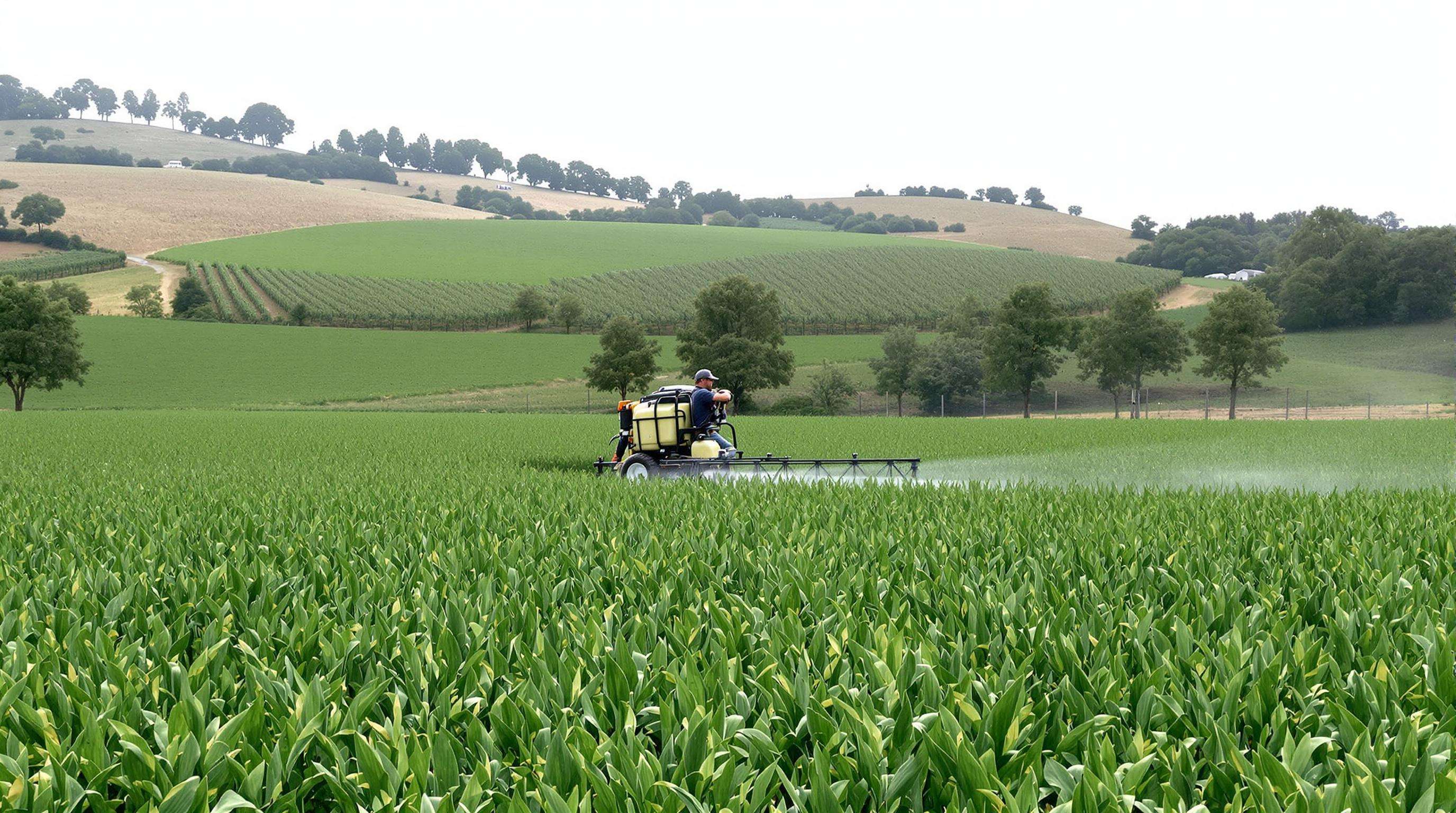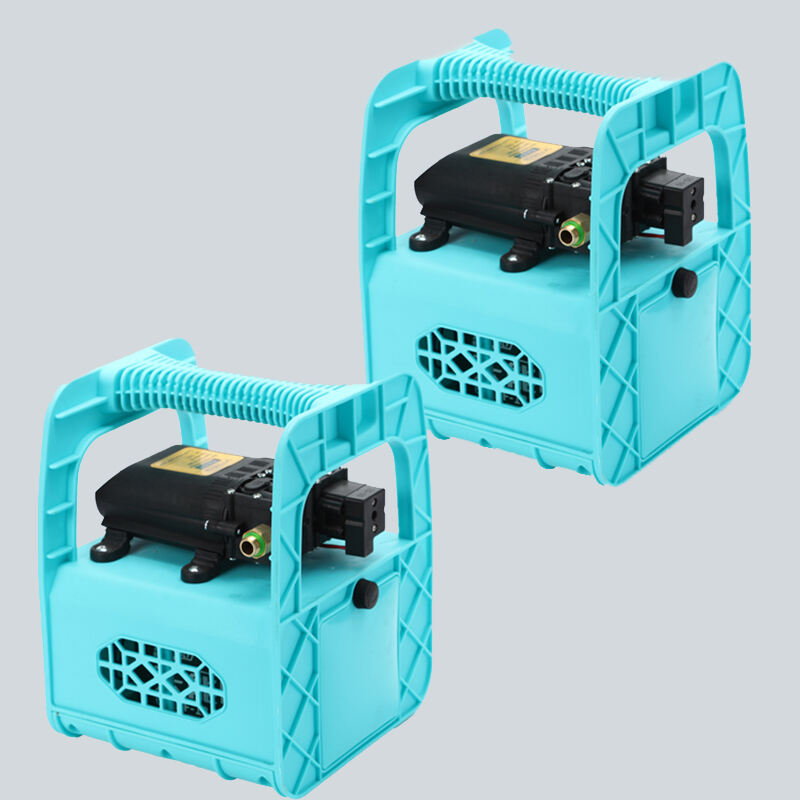Как переносные опрыскиватели способствуют внедрению точного земледелия

Роль технологии точного опрыскивания в современном сельском хозяйстве
Точное земледелие меняет способ ведения ферм, используя технологии для более эффективного управления ресурсами, а портативные опрыскиватели стали действительно важными инструментами для нанесения обработок именно туда, где они необходимы. Эти небольшие системы позволяют фермерам распределять химикаты только на проблемных участках, вместо того, чтобы тратить средства на целые поля. Фермеры могут быстро реагировать, как только замечают вредителей, поедающих урожай, или участки, требующие дополнительных питательных веществ, что снижает сток химикатов в близлежащие водоемы. Благодаря своей мобильности эти опрыскиватели отлично работают на склонах, между рядами деревьев или в любом месте, куда крупная техника не сможет пройти, не повредив растения.
Точное нанесение пестицидов, удобрений и гербицидов с использованием портативных опрыскивателей
Портативные опрыскиватели сегодня довольно эффективно справляются с задачей точного нанесения химикатов благодаря регулируемым соплам и улучшенным настройкам давления. Фермеры и садоводы могут обрабатывать корни растений, труднодоступные нижние части листьев или даже пространства между рядами, не расходуя вещество впустую. Это подтверждается и статистикой: исследования показывают, что использование химикатов можно сократить примерно на 18–23% по сравнению со старыми методами. Также не стоит забывать и о факторе удобства. Когда оборудование удобно в использовании, работники дольше сохраняют правильное расстояние и угол нанесения, что обеспечивает более равномерное покрытие обрабатываемой поверхности.
Оптимизация размера капель, охвата и объема распыления для максимальной эффективности
Работа зависит от баланса трех ключевых переменных:
| Коэффициент корректировки | Воздействие | Преимущество оптимизации |
|---|---|---|
| Размер капель | Размер = Снос, Испарение Размер = Покрытие |
Сопла с подачей воздуха создают идеальные капли размером 150–300 мкм |
| Объём распыления | Объем = Риск стока Объем = Недостаточное покрытие |
Контроллеры потока обеспечивают стабильный расход литров на гектар |
| Шаблон покрытия | Равномерное распределение предотвращает пропуски и переувлажнение | Веерные сопла с углом 110 градусов обеспечивают равномерное осаждение |
Калибровка корректирует эти параметры в зависимости от типа химического вещества, стадии роста культуры и погодных условий, обеспечивая оптимальные результаты
Преимущества на основе данных: Снижение химического дрейфа до 30% при правильной калибровке
Правильная калибровка оборудования может сократить химический дрейф способами, которые дают ощутимый результат. Некоторые полевые испытания, проведенные в различных сельскохозяйственных регионах, показали, что переносные опрыскиватели, находящиеся в хорошем состоянии, уменьшают дрейф на 25–30%, по сравнению с теми, которые вообще не калибровались. Фермеры знают, что это важно, поскольку снижается вероятность попадания химикатов на соседние посевы или загрязнения местных источников воды. Согласно исследованиям, поддерживаемым USDA (Министерством сельского хозяйства США), регулярное техническое обслуживание, включая проверку давления, замену изношенных сопел и периодические испытания распыления, является абсолютно критически важным для того, чтобы обеспечить эффективный контроль дрейфа на протяжении времени. Эти простые меры не только защищают окружающую среду, но и экономят деньги в долгосрочной перспективе за счет повышения эффективности нанесения.
Аккумуляторные и ручные переносные опрыскиватели для мелких ферм
Мелкие фермеры должны учитывать компромиссы между аккумуляторными и ручными переносными опрыскивателями, поскольку каждый из них имеет свои преимущества в плане эффективности, трудозатрат и стоимости.
Сравнение эффективности на поле, потребности в рабочей силе и потребности в обслуживании
Согласно последним отчетам об использовании сельскохозяйственной техники в 2024 году, опрыскиватели, работающие на батареях, выполняют работу примерно на 20–35% быстрее на гектар по сравнению со старыми ручными моделями. Электрические опрыскиватели поддерживают постоянное давление во время работы, поэтому фермерам не нужно постоянно останавливаться, чтобы накачать их, что обеспечивает более равномерное покрытие при опрыскивании полей. Что касается обслуживания, между двумя типами существует довольно значительная разница. Электрическим моделям в целом требуется очистка сопел каждые пару недель и регулярная подзарядка батареи. Ручные опрыскиватели требуют другого подхода: при износе насосов после многократного использования необходимо периодически заменять уплотнения. Большинство фермеров считают, что эти аспекты обслуживания стоит учитывать при выборе типа опрыскивателя, наиболее подходящего для их сельскохозяйственных операций.
Исследование на практике: Сокращение трудозатрат на 40% в садоводстве с использованием опрыскивателей с батарейным питанием
Полевые испытания в выращивании клубники показывают, что опрыскиватели с батарейным питанием повышают производительность на 40%, при этом рабочие обрабатывают 0,8 акра в час по сравнению с 0,5 акрами при использовании ручных насосов. Снижение физических нагрузок способствует этому приросту. Кроме того, современные системы контроля давления минимизируют потери раствора, что приводит к на 22% меньшему времени простоя для дозаправки по сравнению с традиционными системами.
Стоимость, доступность и пригодность для различных типов культур
| Фактор | Ручные опрыскиватели | Батарейные опрыскиватели |
|---|---|---|
| Первоначальная стоимость | $30$120 | $150$400+ |
| Ежегодное обслуживание | $15$40 | $50$100 |
| Оптимальные типы культур | Травы, микрозелень | Сады, виноградники |
Ручные опрыскиватели остаются популярными на городских фермах площадью менее одного акра, тогда как модели с батареями оказываются более экономичными для культур, требующих частых обработок. Производители томатов, например, обычно окупают более высокие первоначальные затраты в течение 18 месяцев за счёт экономии на рабочей силе. Оба типа теперь поддерживают модульные конструкции, позволяющие быстро менять сопла для различных химических веществ.
Умные портативные опрыскиватели: интеграция GPS и Интернета вещей для продвинутого управления
Интеграция GPS и датчиков Интернета вещей в умных портативных опрыскивателях
Портативные опрыскиватели, оснащенные датчиками с GPS и подключением к интернету, могут в реальном времени наносить на карту поля, отслеживать места нанесения химикатов и при необходимости корректировать процесс во время работы. Эти машины работают с GPS, обеспечивающим точность до сантиметра, а также проверяют уровень влажности почвы, анализируют погодные условия и состояние здоровья урожая перед тем, как принимать решение о месте опрыскивания. Согласно исследованию, опубликованному в прошлом году, фермеры, перешедшие на использование таких интеллектуальных опрыскивателей, смогли сократить перекрытие зон опрыскивания примерно на 18 процентов по сравнению со старыми ручными методами. Это означает меньший расход химикатов при сохранении полного покрытия всех необходимых участков сельскохозяйственных угодий.
Контроль в реальном времени и применение переменных норм для оптимизации расхода материалов
Опрыскиватели, подключенные к интернету, могут регулировать объем наносимых химикатов в зависимости от данных, получаемых с сенсоров на поле, например, от плотности роста растений или количества вредителей в определенных зонах. Согласно отчету отраслевого издания Croplife за 2023 год, фермеры, внедрившие эту технологию, обычно экономили от 20% до 35% на используемых материалах, не снижая урожайность. Возьмем, к примеру, клубнику. Фермеры, экспериментировавшие с такими интеллектуальными опрыскивателями, сократили применение фунгицидов примерно на 27%, но при этом успешно сохраняли растения от болезней. Экономия со временем возрастает, особенно при использовании дорогостоящих сельскохозяйственных химикатов.
Соотношение высоких первоначальных затрат и долгосрочной окупаемости, а также выгод в плане устойчивого развития
Умные опрыскиватели действительно стоят дороже — примерно на 30–50 % по сравнению с обычными. Однако со временем они окупаются за счёт снижения потребности в химикатах, повышения производительности персонала и упрощения соблюдения требований регуляторов. Взгляните на то, что произошло на ферме в Среднем Западе, выращивавшей сою, в течение трёх сезонов. Владельцы зафиксировали рост прибыли почти на четверть на акр за счёт сокращения расходов и избежания штрафов за загрязнение сточными водами. Кроме того, все эти датчики и подключённые устройства формируют подробные отчёты, которые фермам всё чаще требуются при подаче заявок на программы сертификации экологичности. Крупные продуктовые сети и рынки экспорта начинают требовать подтверждения устойчивых методов ведения хозяйства, поэтому наличие качественной документации сегодня делает огромное влияние на рынок.
Применение в садоводстве, тепличных хозяйствах и городском землепользовании
Целевой контроль вредителей и сорняков в ограниченных и чувствительных средах
Портативные опрыскиватели отлично работают в ограниченном пространстве или в местах, где необходимо быть осторожным, чтобы химикаты не попали не туда. Например, теплицы или сады, где различные растения растут близко друг к другу. Регулируемые сопла позволяют фермерам точно контролировать объем распыляемой жидкости и направлять ее именно туда, куда нужно, например, на одну грядку, не повреждая соседние растения. Большинство моделей также оснащены регуляторами давления, которые помогают уменьшить дрейф при опрыскивании возле нежных культур. Для владельцев органических ферм или тех, кто придерживается комплексной системы защиты растений (IPM), такая точность имеет решающее значение. Вместо того чтобы обрабатывать целые поля пестицидами, фермеры могут обрабатывать только проблемные участки, сохраняя низкий уровень общего использования химикатов. Некоторые хозяйства сообщают, что после перехода на такие точечные системы опрыскивания объем применения пестицидов сократился вдвое.
Оптимизация частоты и объема опрыскивания в тепличных хозяйствах
Руководители теплиц используют программируемые переносные опрыскиватели, чтобы согласовать обработку с развитием культур и условиями микроклимата. Модели с интеграцией IoT регулируют подачу в соответствии с текущей влажностью и температурой, предотвращая чрезмерное использование в деликатных системах, таких как рассадные лотки или гидропонные установки. Эти возможности снижают риск заболеваний, передаваемых через воду, на 18% благодаря равномерному распределению капель.
Растущая тенденция: внедрение в вертикальные и городские системы сельского хозяйства
Портативные опрыскиватели достаточно малы и точны, чтобы отлично работать на городских фермах и в тех вертикальных системах выращивания, которые мы видим повсюду в последнее время. Фермеры, перешедшие на подключенные к IoT опрыскиватели, сообщили, что потребление химикатов снизилось примерно на 40% согласно техническим оценкам конца 2025 года. На перспективу большинство прогнозов предполагают, что фермы с контролируемой окружающей средой начнут внедрять эти системы примерно в три раза быстрее текущих темпов к 2030 году. Наибольший рост наблюдается в хозяйствах, выращивающих листовые овощи и микрозелень, где растениям требуется регулярная, но точная обработка питательными веществами и пестицидами.
Экологические преимущества эффективных портативных опрыскивателей
Снижение использования химикатов и экологического воздействия за счет точного нанесения
Портативные опрыскиватели могут сократить химический дрейф примерно на 30% благодаря исследованиям Global AgTech Initiative за 2023 год. Это достигается за счет более точного контроля размера капель и распределения распыления. Традиционные методы рассеивания просто разбрасывают химикаты повсюду, тогда как новые прецизионные сопла обрабатывают только конкретные участки. Фермеры сообщают, что экономят около 45% избыточного применения химикатов при выращивании сои, что имеет большое значение. Преимущества не ограничиваются лишь экономией средств. Эти точные методы помогают сохранить здоровье почвенных микроорганизмов и защищают близлежащие водные пути. Задумайтесь: сельскохозяйственный сток отвечает примерно за 70% загрязнения рек по всему миру. Таким образом, умное опрыскивание – это не просто выгодный бизнес, это необходимость для защиты окружающей среды.
| Традиционное и прецизионное опрыскивание |
|---|
| 1215% избыточного распыления химикатов |
| 40% риска стока в тяжелых почвах |
Оптимизация внесения и снижение стока: на 25% меньше загрязнения
Спринклеры, работающие от батареек и оснащенные датчиками потока, сокращают расход воды и удобрений примерно на 20–25%, поскольку регулируют подачу в зависимости от густоты роста растений. Фермеры, занимающиеся выращиванием миндаля и винограда, также отметили интересный эффект при переходе на эти системы с переменной нормой подачи: их урожай увеличивается примерно на 18%, и при этом они экономят на химикатах. Особенно умные фермеры подключают эти устройства интернета вещей к датчикам влажности почвы, чтобы точно знать, когда не следует проводить опрыскивание в жаркие дни, когда всё просто испаряется. Исследования показывают, что такой подход позволяет сократить загрязнение грунтовых вод в сухих регионах примерно на треть по сравнению с традиционными методами.
Поддержка экологически эффективных практик в современном и регенеративном земледелии
Портативные опрыскиватели способствуют регенеративному земледелию, обеспечивая:
- Сохранение покровных культур : Селективное применение гербицидов сохраняет растительность, защищающую почву
- Поддержка секвестрации углерода : Меньше обработки почвы благодаря точному контролю сорняков
- Защита биоразнообразия : На 62% меньше негативного воздействия на опылителей по сравнению с авиационным опылением
Агрономы отмечают, что эти инструменты способствуют масштабированию сельского хозяйства с низким уровнем ввода ресурсов без потери эффективности. Фермы по производству латука в Калифорнии, использующие точечное опыление, получили сертификат USDA Organic на 40% быстрее, чем при традиционных методах перехода.
Часто задаваемые вопросы
Каковы основные преимущества портативных опылителей в точном земледелии?
Портативные опылители обеспечивают точное нанесение пестицидов и удобрений, уменьшая химические отходы и экологическое воздействие. Они позволяют фермерам оперативно решать конкретные проблемы, такие как вредители или нехватка питательных веществ.
Как умные портативные опылители повышают эффективность сельского хозяйства?
Умные опылители интегрируют GPS и датчики интернета вещей для точного картирования и нанесения. Они уменьшают перекрытие химикатов и регулируют нормы внесения в зависимости от текущих условий, оптимизируя использование ресурсов.
Почему фермерам-малышам стоит рассматривать опылители с батарейным питанием?
Аккумуляторные опрыскиватели обеспечивают повышенную эффективность и снижают физические нагрузки по сравнению с ручными опрыскивателями. Они поддерживают стабильное давление для более равномерного покрытия и требуют меньшего обслуживания.
Какие преимущества для устойчивого развития обеспечивают портативные опрыскиватели?
Эффективные портативные опрыскиватели уменьшают дрейф и сток химических веществ, сохраняя водные пути и здоровье почвы. Они способствуют практикам регенеративного земледелия, позволяя точно наносить химические вещества и снижать их воздействие.
Содержание
-
Как переносные опрыскиватели способствуют внедрению точного земледелия
- Роль технологии точного опрыскивания в современном сельском хозяйстве
- Точное нанесение пестицидов, удобрений и гербицидов с использованием портативных опрыскивателей
- Оптимизация размера капель, охвата и объема распыления для максимальной эффективности
- Преимущества на основе данных: Снижение химического дрейфа до 30% при правильной калибровке
- Аккумуляторные и ручные переносные опрыскиватели для мелких ферм
- Умные портативные опрыскиватели: интеграция GPS и Интернета вещей для продвинутого управления
- Применение в садоводстве, тепличных хозяйствах и городском землепользовании
- Экологические преимущества эффективных портативных опрыскивателей
-
Часто задаваемые вопросы
- Каковы основные преимущества портативных опылителей в точном земледелии?
- Как умные портативные опылители повышают эффективность сельского хозяйства?
- Почему фермерам-малышам стоит рассматривать опылители с батарейным питанием?
- Какие преимущества для устойчивого развития обеспечивают портативные опрыскиватели?

